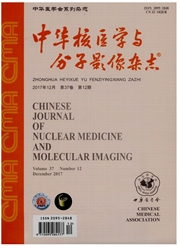

 中文摘要:
中文摘要:
目的基于模块化思想,通过将具有荧光成像特性的量子点复合到具有超声响应特性的高分子微泡中,制备超声/荧光双模态医学造影剂。方法将500mg聚乳酸、50mg樟脑、0.5ml油酸修饰的硒化镉/硫化锌量子点(cdse/zns,2.3μmol/L)溶解分散于10m1二氯甲烷形成有机相,用碳酸铵溶液构成内水相,用聚乙烯醇溶液构成外水相,采用双乳溶剂挥发法和冷冻干燥技术相结合的方法制备兼具超声/荧光双模态成像功能的荧光微泡。用扫描电子显微镜观察荧光微泡形貌,以荧光分光光度计对其发光性能进行表征。搭建体外超声/荧光成像装置,以推注生理盐水的声像图为对照,观察装置中硅胶管注人荧光微泡后的超声对比增强情况和荧光增强情况及两者同步成像效果。评价荧光微泡在体内超声/荧光双模式下对新西兰大白兔。肾脏的成像效果。结果荧光微泡呈规则的球形,具有中空结构,平均粒径为(1.62±1.47)μm,超过99%的微泡直径小于8μm,能够满足超声造影剂大小的基本要求;荧光微泡的荧光发射峰位于632nm,并能维持量子点良好的发光特性。体外超声/荧光成像结果示:管腔充满生理盐水时,声像图呈完全无回声;推注荧光微泡后,有造影剂的部分回声增强;紫外灯照射下,有造影剂的液柱见明亮红色荧光。推注荧光微泡后,兔肾脏在声像图上清晰显影。结论成功制备基于聚合物微泡的超声/荧光双模态造影剂,该造影剂具有良好的回声特性和荧光成像能力,可以弥补单一造影剂的缺陷与不足。
 英文摘要:
英文摘要:
Objective To fabricate an ultrasound/fluorescence bimodal contrast agent by encapsula ting fluorescent quantum dots into polymeric ultrasound contrast agent microbubbles. Methods Polylactic acid (PLA, 500 mg), (1R)( + )camphor (50 nag) and CdSe/ZnS quantum dots (0. 5 ml, 2.3 μmol/L) were dissolved or dispersed in diehloromethane ( 10 ml) to form in an organic phase. Ammonium carbonate solution and poly (vinyl alcohol) solution were employed as the internal and external water phase, respectively. The fluorescent microbubbles were generated using double emulsion solvent evaporation and lyophilization methods. The morphology and illumination were characterized by scanning electron microscopy (SEM) and fluorescence speetrophotometry. Synchronized contrastenhanced ultrasound and fluorescence imaging was acquired by injecting fluorescent microbubbles into the silicone tube coupled to a selfmade ultrasound/fluorescence imaging device. Ultrasound/fluorescence bimodal in vivo imaging was acquired on the kidney of New Zealand rabbits and suckling mice. Results The fluorescent microbubbles were hollow spheres with an averaged diameter of ( 1.62 ± 1.47 ) μm. More than 99% of these mierobubbles were less than 8 μm in diameter, which meeted the size criteria for ultrasound contrast agents. The fluorescence emis sion peak of the mierobubbles appeared at 632 nm, indicating that good luminescence properties of quantum dots were maintained. In vitro ultrasound/fluorescence imaging showed no echoic signal when the silicone tube was filled with saline, but there was a strong echo when filled with fluorescent microbubbles. The liq uid column with fluorescent microbubbles emitted red luminescence under ultraviolet irradiation. The kidney of the rabbit was remarkably enhanced after the administration of fluorescent microbubbles. Bright fluores cence could be observed at the injection site of the suckling mice via subcutaneous injection. Conclusions A bimodal but single contrast agent based on p
 同期刊论文项目
同期刊论文项目
 同项目期刊论文
同项目期刊论文
 Bifunctional gold nanorod-loaded polymeric microcapsules for both contrast-enhanced ultrasound imagi
Bifunctional gold nanorod-loaded polymeric microcapsules for both contrast-enhanced ultrasound imagi New Insight into Surface Properties of Self-Assembled Monolayer and Langmuir-Blodgett Film of an Amp
New Insight into Surface Properties of Self-Assembled Monolayer and Langmuir-Blodgett Film of an Amp Fabrication of zonal thiol-functionalized silica nanofibers for removal of heavy metal ions from was
Fabrication of zonal thiol-functionalized silica nanofibers for removal of heavy metal ions from was A novel amperometric biosensor based on single walled carbon nanotubes with acetylcholine esterase f
A novel amperometric biosensor based on single walled carbon nanotubes with acetylcholine esterase f Nanofibrous Lipid Membranes Capable of Functionally Immobilizing Antibodies and Capturing Specific C
Nanofibrous Lipid Membranes Capable of Functionally Immobilizing Antibodies and Capturing Specific C Selective content release from light-responsive microcapsules by tuning the surface plasmon resonanc
Selective content release from light-responsive microcapsules by tuning the surface plasmon resonanc Nanocoating of diazoresin/polysaccharides multilayer boosts biocompatibility of Nitinol biomedical d
Nanocoating of diazoresin/polysaccharides multilayer boosts biocompatibility of Nitinol biomedical d Selective antileukemia effect of stabilized nanohybrid vesicles based on cholesteryl succinyl silane
Selective antileukemia effect of stabilized nanohybrid vesicles based on cholesteryl succinyl silane Gold nanoshelled microcapsules: a theranostic agent for ultrasound contrast imaging and photothermal
Gold nanoshelled microcapsules: a theranostic agent for ultrasound contrast imaging and photothermal Fabrication of gelatin nanofibrous scaffolds using ethanol/phosphate buffer saline as a benign solve
Fabrication of gelatin nanofibrous scaffolds using ethanol/phosphate buffer saline as a benign solve 期刊信息
期刊信息
